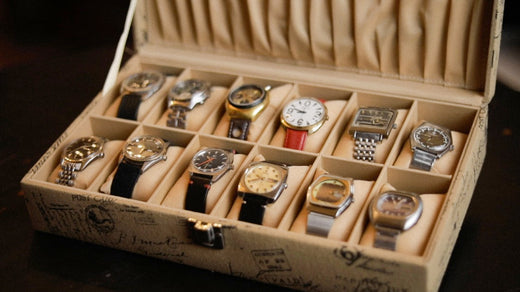How To Care For Your Vintage Watch

Understanding the working of a good vintage watch is often considered too out of depth to the normal man. In reality, it's as simple as separating the wheat from the chaff.
The inner workings of a vintage watch are as delicate as its fine craftsmanship. Aside from that, vintage brands protect their own kind. For example, Patek Philippe vintage watches are sold at such high prices because the brand itself invested in keeping them everlasting.
Also, the entire reason they are classified as vintage and not outdated is because their technology can withstand the test of time. How ironic is that!
Vintage watch part replacements are not easy to come by and ideally should never be replaced. That's as good as replacing a body part on a Michelangelo sculpture. However, no watch was created as a vintage watch, and even the best craftsmanship can be flawed. That's why it is of utmost importance to take proper care of your vintage watch.

A normal watch should ideally be serviced every 10 years. But a vintage watch is a bit of a double-edged sword. Since they are not really in use and are more of a collector’s item, they technically do not need servicing very often.
Unless something is extremely wrong, it is best to leave your vintage watch alone. Servicing it at any repair center can often do more harm than good as these watches need to be handled by a highly trained professional.
The repair person should not only have in-depth knowledge about watches but also watches from the time period of your vintage watch.
However, you should get your vintage watch checked out if you have just bought it. It may save you plenty of money in the long run and determines the authenticity of the watch.

Most vintage watches bought on auction come with their letter of authenticity and are usually the safest bet when adding to a collection. The true diamonds in the rough come from other collectors or second-hand heirlooms that have been passed through the generations. When buying second-hand watches, there is a high hit-and-miss possibility or you may have just won the lottery.
Everlasting but not invincible. These vintage watches often incur some damage and need to be repaired. In such a situation it is important to find authentic replacement parts as well as the right repairman.
Most people often resort to eBay and other such websites but that is not always the safest option. Ideally, your repair shop should be able to guide you to the right spot. Companies like Rolex will not only completely repair your vintage watch but also polish it and restore it to its former glory.

If you would rather maintain the rustic used look, as most people do, then you have a better chance with an independent watch repair person. Experts suggest not changing any of the original watch parts unless absolutely necessary.
You must examine whether you are more focused on the functionality or collectibility of your watch. If a perfectly functioning watch is your priority, then you may have to compromise on the originality of some of the replaced parts. You may not receive replacement parts of the exact same model but maybe a close replica of sorts. If you are in it for collectability, then it is of utmost importance that you keep everything as it was.
This brings us to the everyday maintenance of your vintage watch. If you live in a country with high humidity, then this one's for you. Humidity can affect the inner machinery of a vintage watch and even the tiniest of shifts in accuracy can be problematic in the long run.

Since most of the watch parts are metallic, the temperature cannot fluctuate too often as well. The ideal environment for these watches is a temperature-controlled airtight box that is well-padded and kept away from direct sunlight.
Worst case scenario, do not take it in the shower with you! Although most brands boast about waterproofing these days, you must remember that waterproofing is a relatively new concept. Preferably, one should avoid even sneezing in the vicinity of these precious artefacts.
As tempted as you are to show off your watch to the world, owning a vintage watch comes with responsibility as well. Part of the maintenance is having the watch insured. These watches are easy targets for quick thefts and should be protected for the sentiment, if not the money.
Another thing to avoid is overwinding your vintage watch. The usual manual winding mechanism states that you should wind the watch in a clockwise direction until it cannot be wound anymore. If you are doing so, then you need to be regular with it and wind it once every day, so that the mechanism does not overstrain and overwind.
Even during this process, the watch must be kept on a flat surface. Dropping a vintage watch often causes irreversible damage to either your watch or your bank account.

Vintage watches carry high magnetism. Although it seems like an ancient concept, magnetic/electric devices are the most common cause of the abnormal running of a watch. You can also invest in a demagnetiser that is easily available online.
One of the myths about vintage watches is that you need a watch winder. These pieces were made to last and you don't need these gadgets to keep them going.
The next myth is that you can tell if a watch is original just by looking at it. There is only one way of knowing whether the vintage watch is an original and that is by being the first owner.
Lastly, do not expect these pieces to be as accurate as your smartphone. Sure, they are beautiful and extremely precious but if they were that perfect, then no one would have invented the digital watch.
All in all, a vintage watch is a perfect accessory for people all over the world. During the pandemic, vintage watches witnessed a sharp spike in sales. So if you are one of these people who has bought one or is planning on investing, now you know how to take care of it.







